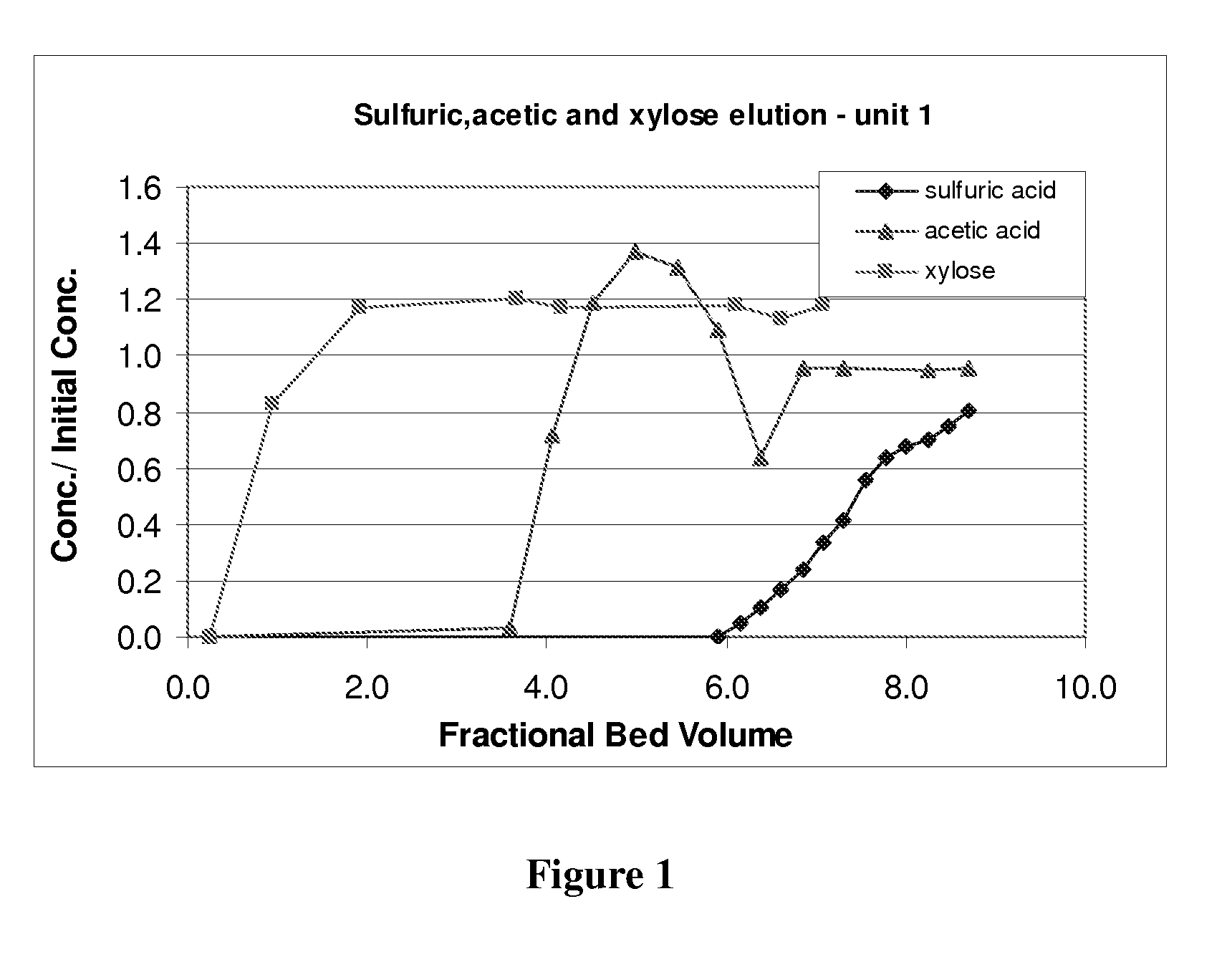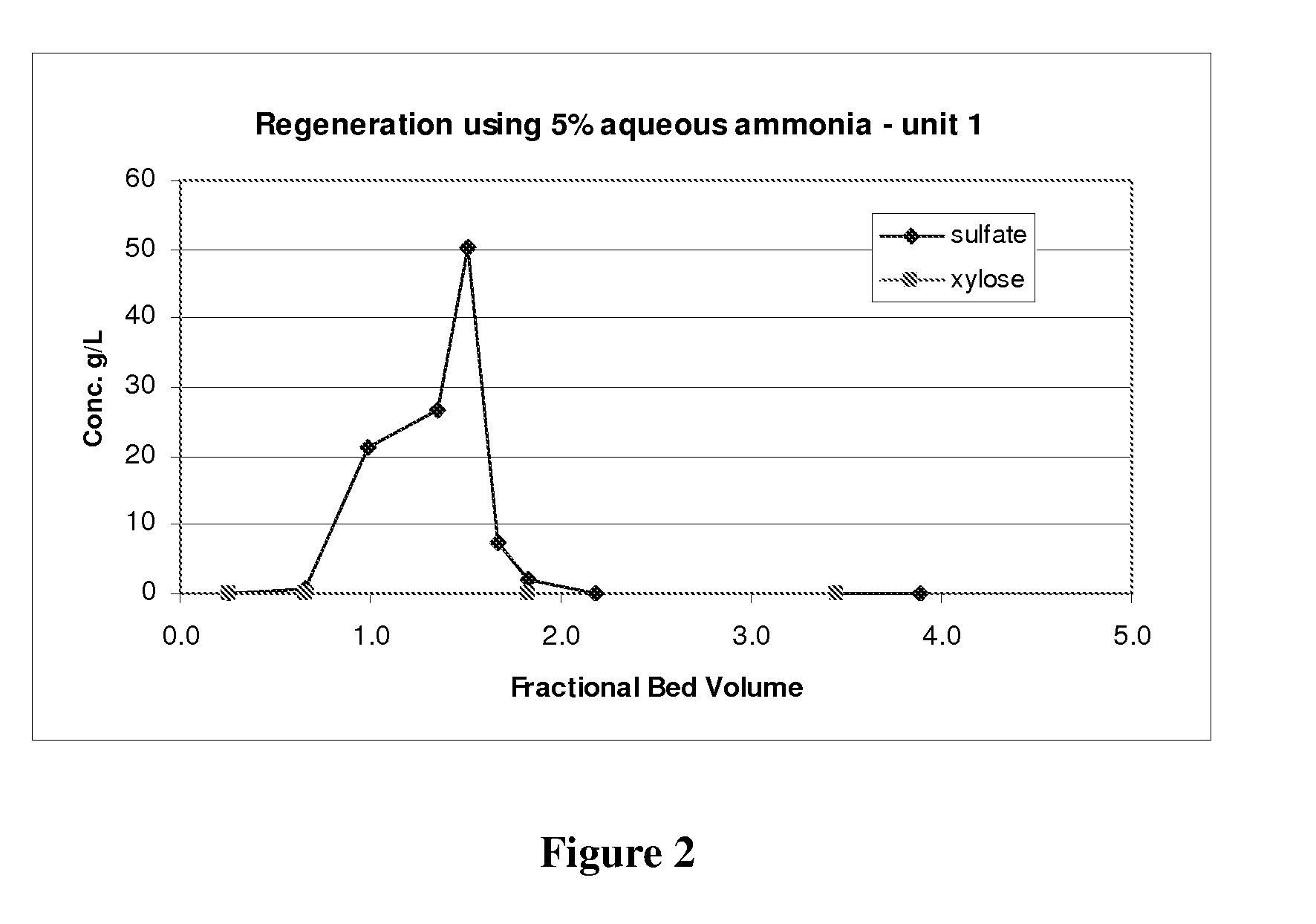Method of obtaining an organic salt or acid from an aqueous sugar stream
a technology of organic salt and organic acid, which is applied in the direction of ion-exchangers, cation exchangers, component separation, etc., can solve the problems of increasing the surface area of cellulose, reducing the recovery rate of cellulose, and reducing the production efficiency of cellulose from these feedstocks. , to achieve the effect of avoiding this cost and facilitating recovery and further processing
- Summary
- Abstract
- Description
- Claims
- Application Information
AI Technical Summary
Benefits of technology
Problems solved by technology
Method used
Image
Examples
example 1
Separation of Sulfuric Acid from a Xylose Stream Using the First Unit of a Two-Unit Anion Exchange System
[0113]An aqueous stream comprising xylose, sulfuric acid and acetic acid was prepared from wheat straw by using a steam and sulfuric acid pretreatment as described by Foody (U.S. Pat. No. 4,461,648, which is incorporated herein by reference). The pretreated wheat straw washed with water and the resulting sugar stream comprised the components shown in Table 1. The stream had a pH of 1.2. The sugar stream also comprised other organic acids, hexoses and other pentose sugars. Sulfuric and acetic acid concentration was measured using a Dionex ICS-2500 HPLC equipped with Chromeleon® software (version 6.6), an IonPac® AS11-HC column (4×250 mm), an AG11-HC guard column (4×50 mm), a conductivity detector and an anion self-regenerating suppression ultra-II system (ASRS-Ultra II). The method used an isocratic 1 mM NaOH mobile phase from 1 to 15 minutes, a 1 to 60 mM NaOH gradient mobile pha...
example 2
Separation of Acetic Acid from Xylose in the Second Unit of a Two-Unit Anion Exchange System
[0118]An aqueous stream comprising xylose, sulfuric acid and acetic acid was produced from wheat straw by using a steam and sulfuric acid pretreatment as described by Foody in U.S. Pat. No. 4,461,648 and the pretreated wheat straw washed with water to produce a sugar stream which was then fed to a first unit of a two-unit anion exchange separation system as described in Example 1. The resulting aqueous sugar stream obtained from a pooled effluent of the first unit comprised the components reported in Table 3 below. The sugar stream also comprised other organic acids, hexoses and other pentose sugars. The pH of this stream was 3.5. This sugar stream was fed to the second unit of the two-unit system containing the same resin as in Example 1. This column had a bed volume of 50 mL and a diameter of 1.2 centimeters. The second weak base anion exchange column was run at ambient temperature.
TABLE 3F...
example 3
Separation of Sulfuric Acid and Acetic Acid from Xylose in a Two-Unit Anion Exchange System
[0121]An aqueous sugar stream comprising xylose, sulfuric acid and acetic acid was made from wheat straw by using a steam and sulfuric acid pretreatment as described by Foody (U.S. Pat. No. 4,461,648, which is incorporated herein by reference). The pretreated wheat straw washed with water and the resulting sugar stream comprised the components shown in Table 5. The sugar stream also comprised other organic acids, hexoses and other pentose sugars. The stream had a pH of 1.2.
TABLE 5Feed to a two-unit anion exchange systemConcentrationComponent(g / L)Sulfuric acid18.62Acetic acid9.81Xylose50.25
[0122]The stream was fed to the first unit of a two-unit anion exchange system prepared as described in Example 1. The effluent from the first unit was allowed to feed directly onto the second unit without first collecting in fractions or pooling the effluent from the first unit. The second unit was prepared ...
PUM
| Property | Measurement | Unit |
|---|---|---|
| Fraction | aaaaa | aaaaa |
| Volume | aaaaa | aaaaa |
| Volume | aaaaa | aaaaa |
Abstract
Description
Claims
Application Information
 Login to View More
Login to View More - R&D
- Intellectual Property
- Life Sciences
- Materials
- Tech Scout
- Unparalleled Data Quality
- Higher Quality Content
- 60% Fewer Hallucinations
Browse by: Latest US Patents, China's latest patents, Technical Efficacy Thesaurus, Application Domain, Technology Topic, Popular Technical Reports.
© 2025 PatSnap. All rights reserved.Legal|Privacy policy|Modern Slavery Act Transparency Statement|Sitemap|About US| Contact US: help@patsnap.com



